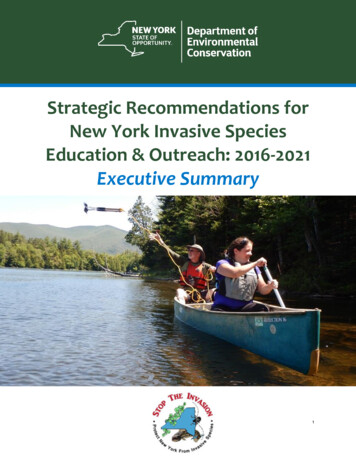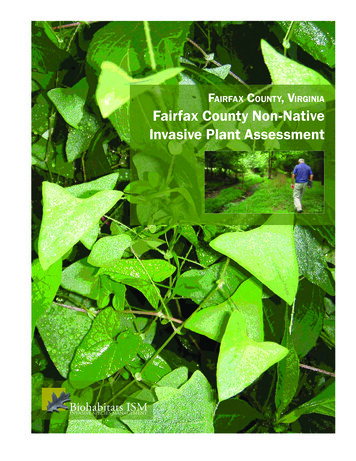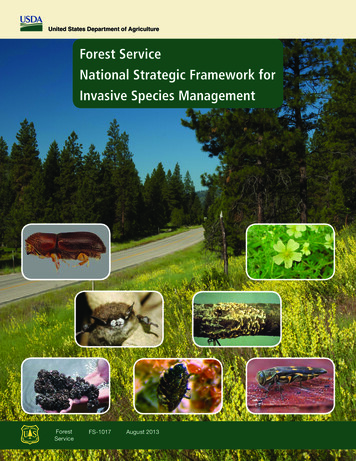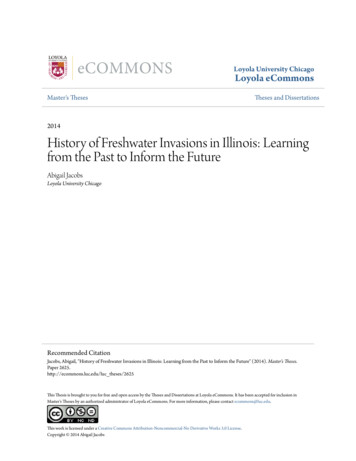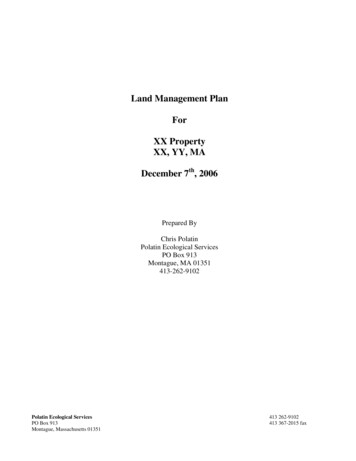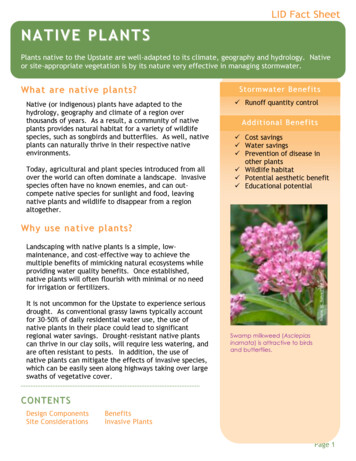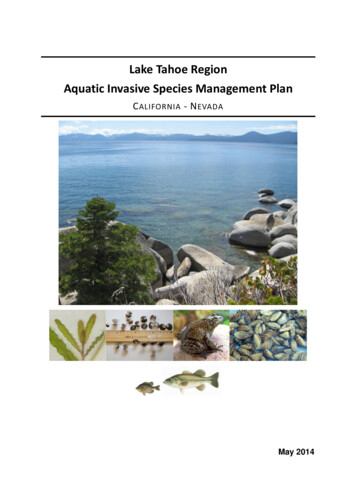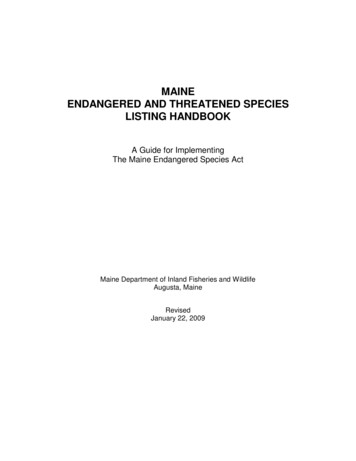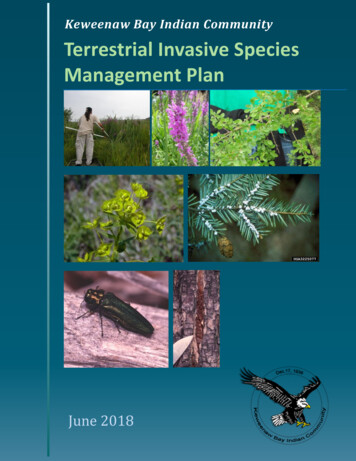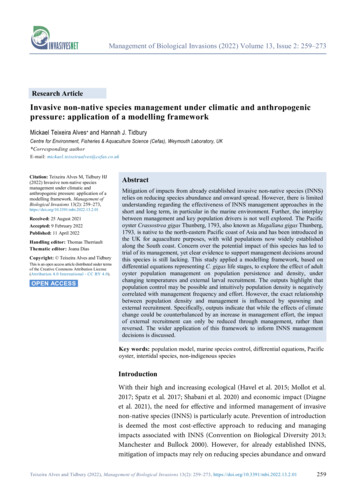
Transcription
Management of Biological Invasions (2022) Volume 13, Issue 2: 259–273CORRECTED PROOFResearch ArticleInvasive non-native species management under climatic and anthropogenicpressure: application of a modelling frameworkMickael Teixeira Alves* and Hannah J. TidburyCentre for Environment, Fisheries & Aquaculture Science (Cefas), Weymouth Laboratory, UK*Corresponding authorE-mail: mickael.teixeiraalves@cefas.co.ukCitation: Teixeira Alves M, Tidbury HJ(2022) Invasive non-native speciesmanagement under climatic andanthropogenic pressure: application of amodelling framework. Management ofBiological Invasions 13(2): Received: 25 August 2021Accepted: 9 February 2022Published: 11 April 2022Handling editor: Thomas TherriaultThematic editor: Joana DiasCopyright: Teixeira Alves and TidburyThis is an open access article distributed under termsof the Creative Commons Attribution License(Attribution 4.0 International - CC BY 4.0).OPEN ACCESS.AbstractMitigation of impacts from already established invasive non-native species (INNS)relies on reducing species abundance and onward spread. However, there is limitedunderstanding regarding the effectiveness of INNS management approaches in theshort and long term, in particular in the marine environment. Further, the interplaybetween management and key population drivers is not well explored. The Pacificoyster Crassostrea gigas Thunberg, 1793, also known as Magallana gigas Thunberg,1793, is native to the north-eastern Pacific coast of Asia and has been introduced inthe UK for aquaculture purposes, with wild populations now widely establishedalong the South coast. Concern over the potential impact of this species has led totrial of its management, yet clear evidence to support management decisions aroundthis species is still lacking. This study applied a modelling framework, based ondifferential equations representing C. gigas life stages, to explore the effect of adultoyster population management on population persistence and density, underchanging temperatures and external larval recruitment. The outputs highlight thatpopulation control may be possible and intuitively population density is negativelycorrelated with management frequency and effort. However, the exact relationshipbetween population density and management is influenced by spawning andexternal recruitment. Specifically, outputs indicate that while the effects of climatechange could be counterbalanced by an increase in management effort, the impactof external recruitment can only be reduced through management, rather thanreversed. The wider application of this framework to inform INNS managementdecisions is discussed.Key words: population model, marine species control, differential equations, Pacificoyster, intertidal species, non-indigenous speciesIntroductionWith their high and increasing ecological (Havel et al. 2015; Mollot et al.2017; Spatz et al. 2017; Shabani et al. 2020) and economic impact (Diagneet al. 2021), the need for effective and informed management of invasivenon-native species (INNS) is particularly acute. Prevention of introductionis deemed the most cost-effective approach to reducing and managingimpacts associated with INNS (Convention on Biological Diversity 2013;Manchester and Bullock 2000). However, for already established INNS,mitigation of impacts may rely on reducing species abundance and onwardTeixeira Alves and Tidbury (2022), Management of Biological Invasions 13(2): 259–273, https://doi.org/10.3391/mbi.2022.13.2.01259
INNS management under climatic and anthropogenic pressurespread (Sundet and Hoel 2016). While there is tendency to focus oneradication as an INNS management endpoint (e.g. Booy et al. 2017, 2020),eradication is rarely feasible, especially in open systems such as the marineenvironment (Thresher and Kuris 2004; Simberloff 2020). Still, sinceimpacts associated with INNS may increase with their density (Sofaer et al.2018), the condition status of priority sites under key legislation may bedriven by the impact of an INNS on site integrity, rather than theirpresence alone (e.g. under The Conservation of Habitats and SpeciesRegulations 2017 (UK 2017)). Therefore, INNS management to reducepopulation density (termed “maintenance management” (Simberloff2020) or “suppression” (Robertson et al. 2020)) needs consideration alongside eradication.INNS management strategies generally fall into three categories:physical, chemical and biological (Herbert et al. 2016; Giakoumi et al. 2019;Simberloff 2020). Such approaches have been successfully implemented tomanage aquatic INNS. For example, in Great Britain freshwater speciessuch as fathead minnow (Pimephales promelas Rafinesque, 1820), blackbullhead catfish (Ameiurus melas Rafinesque, 1820) and topmouthgudgeon (Pseudorasbora parva Temminck and Schlegel, 1846) have beensuccessfully eradicated using chemical control (GBNNSS 2015). However,there have been very few eradication successes in the marine environment,mainly limited to intertidal species, such as the Caribbean black-stripedmussel (Mytilopsis sallei Recluz, 1849) in Cullen Bay, Australia (Bax et al.2002; Simberloff 2020). In general, there is limited understandingregarding the effectiveness of management in the marine environment inthe short and long term (Kopf et al. 2017). In particular, the interplaybetween INNS management and key population drivers remains unclear,largely due to the absence of data and baseline understanding. This is aconcern given that tools used to prioritise management often rely on anunderstanding of its likely success (Booy et al. 2017, 2020). Mathematicalmodelling provides a promising tool to enhance understanding andcontribute to the evidence base which informs INNS management decisions(Vander Zanden and Olden 2008). In particular, population modellingbased on ordinal differential equations can be used to test the impact ofdifferent management strategies, under varied management effort andtemporal frequency, on the density and persistence of INNS populations.The Pacific oyster, Crassostrea gigas Thunberg, 1793 (also known asMagallana gigas Thunberg, 1793), is native to the north-eastern coast ofAsia but has been introduced into the UK for aquaculture purposes (Mann1979). While in the early 1990s only sporadic settlements were reported inthe UK waters, persistent wild C. gigas populations are now widelyreported throughout the UK coastline, especially in Southern England andWales (Herbert et al. 2012; Humphreys et al. 2014). Given the temperaturedependence of maturation and reproduction, the increase in oysterTeixeira Alves and Tidbury (2022), Management of Biological Invasions 13(2): 259–273, https://doi.org/10.3391/mbi.2022.13.2.01260
INNS management under climatic and anthropogenic pressureprevalence is likely the consequence of increased ocean temperaturesassociated with climate change (Rinde et al. 2017; King et al. 2021). Recentwork has also shown that population persistence and density are linked toexternal recruitment, for example via natural dispersal of pelagic life stagesvia ocean currents (Wood et al. 2021) or via anthropogenic transport ofpelagic life stages (e.g. in ship’s ballast) (Anglès d’Auriac et al. 2017), and toresource availability (Teixeira Alves et al. 2021). In the UK, C. gigas may beassociated with ecological impacts such as potential displacement of nativespecies and habitat (Diederich et al. 2005; Ruesink et al. 2005; Smaal et al.2005; Cognie et al. 2006), and socio-economic impacts such as injuriescaused by shells on leisure beaches (Herbert at al. 2016; Reise et al. 2017).Further, if associated with alteration of the ecological integrity of a site, thisspecies may impact the condition classification of protected sites underthe UK Conservation of Habitats and Species Regulations 2017 (UK2017). Given its potential impacts, in combination with its commercialvalue and potential natural dispersal over large distances, the “what”,“how” and “where” with respect to management of this species is thesubject of some debate.Management options for wild C. gigas populations are limited, withfocus on manual removal of adults (Herbert at al. 2016). Though localisedshort-term manual removal of adults has been trialled, conclusive evidencearound the effectiveness of such management on population persistenceand density is not available (McKnight and Chudleigh 2015; Morgan et al.2021). In this study we aim to address this evidence gap in order tofacilitate more informed decisions around C. gigas management into thefuture. Specifically, we applied a modelling framework, based on differentialequations representing C. gigas life stages, to explore the effect of removingadults on population persistence and density. Simulations over a range ofmanagement frequencies (number of management events over 20 years)and management effort (proportion of population removed) per eventwere run. The effect of different spawning frequencies (simulating the effectsof climate change) and levels of external larval recruitment were also explored.The outputs highlight that, intuitively, population density is negativelycorrelated with management frequency and effort but that the exactrelationship is influenced by spawning and external recruitment. Morespecifically, outputs indicate that while the effects of climate change couldbe counterbalanced by an increase in management effort, the impact ofexternal recruitment can only be reduced through management, ratherthan reversed.Materials and methodsCrassostrea gigas life historyPacific oysters can live 20 to 40 years and form reefs in coastal andestuarine waters (Strand et al. 2011). Crassostrea gigas has a very highTeixeira Alves and Tidbury (2022), Management of Biological Invasions 13(2): 259–273, https://doi.org/10.3391/mbi.2022.13.2.01261
INNS management under climatic and anthropogenic pressurefecundity with r-type life history and a strong temperature dependence(Hedge and Johnston 2014). Gametogenesis occurs at the end of the winterat a water temperature above 8 C to 10 C (Fabioux et al. 2005). Spawningusually occurs when water temperatures exceed 18 C to 20 C (Mann 1979;Diederich et al. 2005; Mills 2016), though partial or complete spawningbelow 18 C has been documented (Li and Hedgecock 1998; Chávez-Villalbaet al. 2002; Rico-Villa et al. 2009; Dutertre et al. 2010). The spawningtemperature for C. gigas in Poole, UK, has been estimated at 19.7 C(Pastor et al. 2010). Crassostrea gigas fertilization occurs in the watercolumn, which if successful, results in development of planktonic larvaewhich then metamorphose into juvenile spat (Li and Hedgecock 1998;Rico-Villa et al. 2009; Kheder et al. 2010). Larval development and settlementcan take from 2 to 4 weeks at 25 C and 17 C, respectively, with a longerduration increasing risk of mortality via predation (Kennedy and Breisch1981). Juvenile spat, once settled, are sensitive to low temperatures andcannot survive in waters below 3 C (Child and Laing 1998). Juveniledevelopment to adult oysters can take 1 to 3 years (Helm 2006).Model frameworkDifferential equation-based models have been developed to representstage-structured oyster populations (Jordan-Cooley et al. 2011; Lipcius etal. 2019). This modelling approach was subsequently adapted to incorporatedifferent spawning frequencies and levels of external recruitment andimplemented to examine the drivers of wild oyster population dynamics(Supplementary material Table S1, Teixeira Alves et al. 2021). Specifically,Teixeira Alves et al. (2021) represented spawning frequency as the frequencyof temperature-dependent adult oyster annual reproduction events, andexternal recruitment level as a discrete annual influx of larvae from farmedoyster populations in close proximity or from long-distant wild oysterpopulations spatially distinct from the modelled population (expressed asR, the number of recruited larvae per m2), both occurring under theassumption of optimal pH, salinity, turbidity and oxygen levels. In thepresent study, this modelling framework was extended to incorporatemanagement strategies.ManagementThe modelling framework by Teixeira Alves et al. (2021) was adapted toinclude the discrete removal of adult oysters during a management event attime t 𝜏𝑚 , according to:𝐿 𝐿,𝐽 𝐽,𝑡 𝜏𝑚 𝐴 𝐴(1 𝑚),Teixeira Alves and Tidbury (2022), Management of Biological Invasions 13(2): 259–273, https://doi.org/10.3391/mbi.2022.13.2.01(1)262
INNS management under climatic and anthropogenic pressurewhere L is the number of larvae per m2, J is the number of juveniles per m2and A is the volume of adults per m2 (Table S1). The proportion of theadult population manually removed was defined as the management effort,𝑚, i.e. the proportion of the population that can be physically removedgiven accessibility to population and resources available, and ranged from0 (no removal) to 1 (total adult population removed). The time of theremoval event was such that it occurred prior to spawning.ScenariosTo assess the impact of climate change and external larval recruitment onthe success of C. gigas management, simulations representing a range ofmanagement efforts and frequencies, in combination with different levelsof external recruitment and climate change scenarios (reflected by differentspawning frequencies), were run.Low, moderate and high management effort was associated with theremoval of 0.25, 0.5 and 0.75 of the adult population, respectively, during eachmanagement event. Management events were simulated over 20 years under5 scenarios: 1) no event, 2) events every 10 years, 3) events every 5 years,4) biannual events, and 5) annual events. Spawning frequency was simulatedunder 3 scenarios: 1) no spawning, 2) spawning every 5 years, and 3) annualspawning. External larval recruitment levels were none (R 0), low (R 20larvae.m-2), medium (R 200 larvae.m-2), and high (R 2,000 larvae.m-2).The initial density of established oyster populations was considered low(A0 0.01 m3.m-2), medium (A0 0.05 m3.m-2) or high (A0 0.1 m3.m-2).Simulations were conducted over a period of 20 years and outputs weresummarised as average adult densities at year 20 and number of years beforereaching the management objective defined as a 90% reduction in density.All parameters were based on the literature as detailed in Teixeira Alveset al. (2021) (Table S1). In particular, the level of external larval recruitmentwas based on oyster larvae monitoring data (Pouvreau et al. 2016). InTeixeira Alves et al. (2021), parameter uncertainty due to environmentalvariability (i.e. temperature) was explored using an elasticity analysis,highlighting that model outputs were highly sensitive to spawningthreshold temperature, number of larvae produced by adult volume andconversion of juvenile into adult volume. In the present study, simulationscovered a wide range of environmental and parameter values, representativeof relevant real-world scenarios. All simulations were performed using thestatistical software R (R Core Team 2020) and the package deSolve(Soetaert et al. 2010).ResultsManagement under low spawning frequency and low externalrecruitment levelThe management of populations which spawn irregularly with no or lowlevel external recruitment accelerates population density decline (Figures 1, S1).Teixeira Alves and Tidbury (2022), Management of Biological Invasions 13(2): 259–273, https://doi.org/10.3391/mbi.2022.13.2.01263
INNS management under climatic and anthropogenic pressureFigure 1. The number of years taken for the population density to reduce by 90% over themanagement effort (proportion of population removed per event) for 5 scenarios of managementfrequency (orange: none; olive: every 10 years; green: every 5 years; blue: biannual; pink:annual) with A0 0.1m3.m-2 and (A) R 20 and no spawning, (B) R 200 and no spawning,and (C) R 200 and annual spawning.In particular, under high initial density, with no spawning and low externalrecruitment, the number of larvae is too small to support persistence of theadult population, which naturally declines by 90% of its initial density after8 years, despite no management (Figure 1A). This time reduces to 2, 3 and5 years when moderate removal effort is employed annually, biannuallyand every 5 or 10 years, respectively. However, little difference is seen inpopulation density in the long term between scenarios, as populations tendto extinction across all management and no management scenarios due tosuch a low recruitment.Teixeira Alves and Tidbury (2022), Management of Biological Invasions 13(2): 259–273, https://doi.org/10.3391/mbi.2022.13.2.01264
INNS management under climatic and anthropogenic pressureImpact of more frequent spawningEnvironmental changes, i.e. increased ocean temperature, that permitmore frequent spawning, reduce the impact of management under allscenarios (Figures 1, S1). For example, under high initial density, with nospawning and medium external recruitment, management effort greaterthan or equal to 0.60 reduces population density by greater than 90%(Figure 1B). The time taken for population density to reduce by 90% ishowever dependent on the frequency of management events, taking 2 yearswhen employed annually, up to 15 years when employed every 10 years.Under annual spawning, a 90% reduction in density occurs only ifmanagement effort is greater than or equal 0.60 or 0.70, and managementis employed annually or biannually, respectively (Figure 1C). Moreover,the time taken for the density to reduce by 90% increases from 2 years (nospawning) to 7 years (annual spawning) with management effort of 0.60employed annually.Management under high spawning frequencyand external recruitment levelThe density of populations that spawn regularly and/or have high levels ofexternal recruitment is markedly impacted by management in the shortand long term, irrespective of initial population density (Figures 2, S2). Forexample, under medium initial density, with annual spawning and lowexternal recruitment, the adult population density is reduced by greaterthan 93% under annual and biannual removal frequency and moderateremoval effort (Figure 2A). A reduction in population density by 90% isachieved through multiple management effort and frequency combinations,including an annual management effort of at least 0.25, a biannualmanagement effort of at least 0.45 and a management effort of at least 0.85employed every 5 years. In addition, the density of the adult population isreduced by 30% under moderate removal effort employed every 10 years.However, if management frequency is increased to every 5 years, biannualor annual, management effort can be reduced to 0.40, 0.20 and 0.10,respectively, to achieve a 50% reduction in population density.Impact of high external recruitment levelWhile the density of populations subject to high levels of external larvalrecruitment can be reduced markedly through management, a reduction of90% of the initial density can never be achieved (i.e. high levels of externalrecruitment prevent achievement of the theoretical management objective),irrespective of the initial density, spawning frequency and managementeffort/frequency combination (Figures 2, S2). External larval recruitmentcontributes animals to the population acting to prevent extinction evenunder the most extreme management scenario (complete removal undertakenTeixeira Alves and Tidbury (2022), Management of Biological Invasions 13(2): 259–273, https://doi.org/10.3391/mbi.2022.13.2.01265
INNS management under climatic and anthropogenic pressureFigure 2. The relative density of the adult population after 20 years, relative to its starting density,over the management effort (proportion of population removed per event) for 5 scenarios ofmanagement frequency (orange: none; olive: every 10 years; green: every 5 years; blue: biannual;pink: annual) with A0 0.05m3.m-2, annual spawning, and (A) R 20, and (B) R 2,000.annually). Still, the density of managed populations is lower than unmanagedpopulations, despite high levels of external recruitment. Under mediuminitial density, with annual spawning and high external recruitment, therelative increase in population density is thus less than half (1.5 times theinitial density) under moderate management effort employed annuallycompared to no management (3 times the initial density) (Figure 2B).Comparison of impact from spawning frequency and externalrecruitment levelExternal recruitment level affects the impact of management to a greaterextent than the spawning frequency (Figures S1, S2). For example, the densityof a population which experiences high external recruitment but at mostTeixeira Alves and Tidbury (2022), Management of Biological Invasions 13(2): 259–273, https://doi.org/10.3391/mbi.2022.13.2.01266
INNS management under climatic and anthropogenic pressurespawns every 5 years, is greater than that of a population which spawnsannually, for the same management and initial density. However, thepopulation density predicted under a management effort of 0.90 employedbiannually is similar to that of populations which spawn annually or do notspawn but experience low external recruitment.DiscussionThere is mounting pressure globally to mitigate the increasing ecological,social and economic impacts of INNS (Lovell et al. 2006; Williams et al.2010; Diagne et al. 2021). For already established INNS, mitigation ofimpacts largely relies on management to reduce species abundance andonward spread (Herbert at al. 2016; Sundet and Hoel 2016; Robertson et al.2020; Simberloff 2020). The short- and long-term impact of managementapproaches is complex and difficult to predict in the context of changingclimate and human mediated drivers of population dynamics. This studyapplied a modelling framework to examine the effect of populationmanagement strategies based on manual removal of adults on thepersistence and prevalence of C. gigas, under different spawning andexternal larval recruitment scenarios.The key findings of this study are: 1) a reduction in population densitycan be achieved through the manual removal of adult oysters, withpopulation density negatively correlated with management frequency andeffort, 2) population density increases which result from more frequentspawning, reflecting increased temperatures associated with climate change,reduce the effect of management, implying that management effort andfrequency may need to be upregulated in the future to counteract the impactsof climate change, and 3) the increased population density resulting fromexternal larval recruitment can be reduced with management but notreversed, so that under high external larval recruitment the relative densityis always high, irrespective of the management effort and frequencycombination, though the absolute density reduces as management effortand frequency increase.Climate change may alter the effectiveness and outcome of management.There is a large consensus that mechanical control of INNS is less efficientunder climate change pressure (Hellmann et al. 2008; Pyke et al. 2008;Kernan 2015). Temperature dictates the lifecycle of many INNS and, in thecase of C. gigas, is an important driver of maturation, reproduction andestablishment (Reise et al. 2017; Teixeira Alves et al. 2021). Since thereproductive success of C. gigas substantially improves in warmer waters,climate change may increase the spawning frequency. In addition, climatechange may increase external larval recruitment from aquaculture sites andwild populations through larval dispersion on ocean currents andanthropogenic vectors (Anglès d’Auriac et al. 2017; King et al. 2021; Woodet al. 2021). Management of a population into which external recruitmentTeixeira Alves and Tidbury (2022), Management of Biological Invasions 13(2): 259–273, https://doi.org/10.3391/mbi.2022.13.2.01267
INNS management under climatic and anthropogenic pressuredoes not occur acts to reduce adult density in the short term but alsoreduces the source of subsequent recruitment. For populations subject toexternal recruitment, similar management has less impact as the source offuture external recruitment is not affected, so that the influx of larvaeremains the same. In terms of management, the approach used for a small,isolated population in cold waters is likely to be more feasible, less costlyand less intensive than the approach required to manage a substantialpopulation experiencing frequent spawning and high levels of externallarval recruitment. Such variability highlights the complexity of predictingmanagement outcomes and that management decisions may need to betailored to the specific spatial and temporal context, accounting forenvironmental variability including changes to the frequency, duration andintensity of extreme climate events.A dynamic approach to management is required to optimisemanagement of INNS populations. The accuracy with which the effect ofmanagement can be inferred depends on temporal and spatial understandingof the population size, the local environment, and external environmentaland anthropogenic influences (Escapa et al. 2004; Hily et al. 2009). Thispresents a number of challenges. Firstly, intertidal species, such as C. gigas,may settle underwater and only be detected at low tide, reducing the abilityto estimate population density accurately (McKnight and Chudleigh 2015).It also means that remaining individuals in less accessible marine spacesmay be harder and more time consuming to find and remove, withimplications for the successful management of populations which mayrequire higher, though still feasible, effort to achieve desired outcomes, asdemonstrated in trials conducted in the North East Kent Marine ProtectedAreas (McKnight and Chudleigh 2015; Morgan et al. 2021). In addition,the potential for temporal and spatial changes in spawning frequency viaclimate change and external larval recruitment via natural and anthropogenicpathways highlights the need for continuous review and likely refinementof the management strategy. The ecological and economic balance betweenthe INNS, its impact and its management, also requires consideration(McAfee and Connell 2021). In particular, while negative impacts of C. gigasare documented, such as potential displacement of native species andhabitat (Diederich et al. 2005; Ruesink et al. 2005; Smaal et al. 2005; Cognieet al. 2006), positive impacts of C. gigas reefs have also been presented,including their role in native species restoration (Christianen et al. 2018).Further, the influence of external recruitment on management highlightsthe need for its mitigation, for example, via use of triploid C. gigas inaquaculture (Suquet et al. 2016) or ballast water management (Patil et al.2005), but also in the wider context of the status of neighbouring waters,with emphasis on the value of transboundary cooperation and collaboration(Wood et al. 2021). Finally, while the disparity between economic investmentin management and the costs resulting from INNS needs to be addressedTeixeira Alves and Tidbury (2022), Management of Biological Invasions 13(2): 259–273, https://doi.org/10.3391/mbi.2022.13.2.01268
INNS management under climatic and anthropogenic pressure(Cuthbert et al. 2021), investment in management of a particular INNSshould be proportionate to the impacts caused.Management of INNS predominantly focusses on eradication, which israrely achievable for well-established species and in open systems such asthe marine environment where organisms are not easy to detect, access orcontain (Thresher and Kuris 2004; Simberloff 2020). Consequently, theperception is that marine INNS management failure is high. While examplesof long-term success of maintenance management of marine INNS are notwell known (Simberloff 2020) there is merit to examining the effect ofmaintenance management, especially for circumstances where successfulachievement of management goals depends on targeted reduction inspecies density in a specific location, rather than its complete eradication.While indicating that management may be possible in certain circumstances,this study demonstrates opportunity beyond eradication. In particular,management and its success are focussed on the population density. It isimportant however that these outputs are considered more holistically, forexample, in the context of potential non-target or indirect effects and withbroader and more fundamental social, economic and ecological goals inmind (Prior et al. 2018). This study sheds light on factors which mayimpact the success of INNS management, specifically with respect toenvironmental and anthropogenic pressures. While focussing on C. gigasmanagement, the modelling framework is broadly applicable and can beadapted to determine the feasibility of maintenance management and likelyeffort required for INNS in aquatic and terrestrial environments whileproviding much needed evidence to inform decisions around managementof INNS in light of current and future pressures. However, there is urgentneed for future research into INNS management in order to improvecapability and capacity to tackle this ever increasing global biodiversitythreat. This is particularly true for marine INNS which are consistentlyunderstudied relative to their freshwater and terrestrial counterparts(Crystal-Ornelas and Lockwood 2020) with clear biases in researchtowards specific phyla, topics, habitats, locations, and species (Watkins etal. 2021), limiting the accuracy with which species can be assessed andprioritised for management.AcknowledgementsThe authors thank Nicola McPherson and Paul Stebbing for their input into the initial projectproposal, and the project steering group for their support throughout the project. We would liketo thank the two anonymous reviewers for their constructive comments.Funding declarationThis work was funded by D
While in the early 1990s only sporadic settlements were reported in the UK waters, . Crassostrea gigas life history Pacific oysters can live 20 to 40 years and form reefs in coastal and . (2020) Using structured eradication feasibility assessment to prioritize the management of new and emerging invasive alien species in Europe. .
